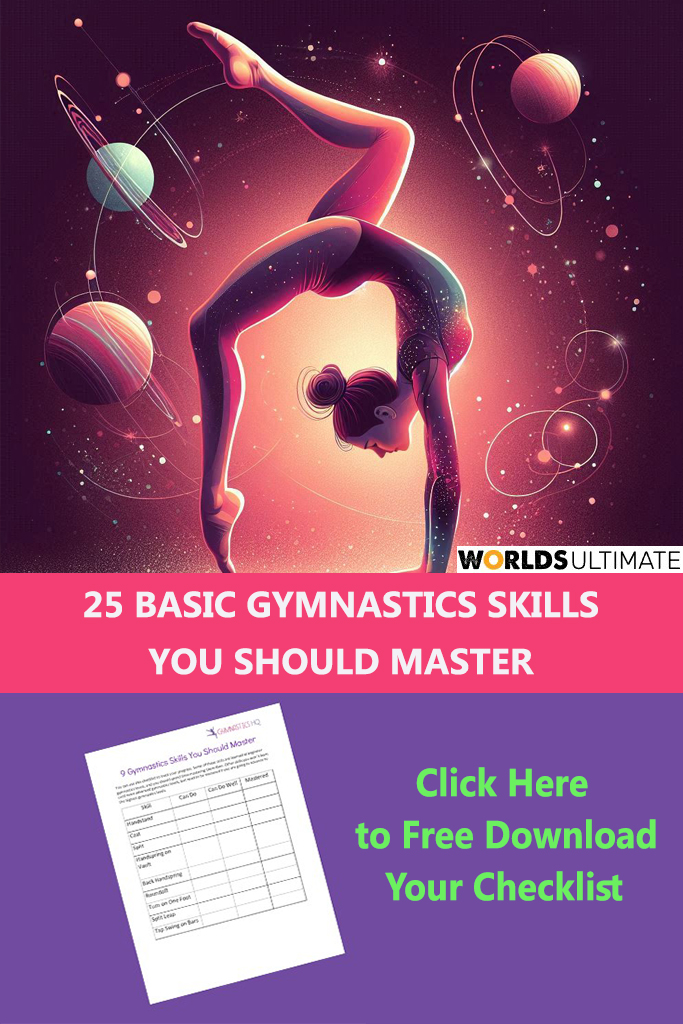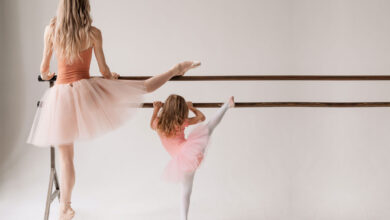Gymnastics Skills for Beginners You Should Master 1-10 Levels
Gymnastics is a sport that nicely combines strength, flexibility, balance & precision. The gymnastics skills that you learn, whether a beginner or an elite gymnast, is like taking one step on the ladder to mastering this form of art. Each move, from hopping to full-fledged cardio-capades or serious floor routines, makes the rest one building block closer.
This lays a foundation of skills that help you become more physically adept, mentally tough, and determined. The journey starts with fundamental skills that are the basic building blocks and advances to more difficult “techniques”. It reaches complex advanced skills, like the really high-level combinations of athleticism and artistry.
Table of Contents
In this guide you will learn about what happens at each stage of that journey and how things look different depending on our abilities or levels in aerobics.
Building Blocks of Gymnastics Techniques
For a gymnast, it all starts by learning to develop the basic skills that are required for specific standards followed by advanced techniques. The reason we place an emphasis on these early skills is, they are the basic building blocks in coordination, balance, strength and flexibility.
One thing that needs to be considered before moving forward is to take care of the hygiene. Make sure to clean your gymnastic bars every time before and after use so that your young ones stay healthy. The aerobic skills are discussed in this section below, providing you the valuable insights and how they can help shape your gymnastics.
1. Hop:
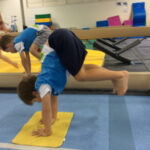
The hop is one of the most basic athletic maneuvers, which act as a gateway to more complicated jumps and leaps. A hop is a one-foot jump that involves taking off and landing on the same foot while maintaining balance during controlled movement.
This skill helps to build coordination, timing and leg strength which are the foundation skills for those other harder elements. Perfecting the hop will help you become more skillful in calisthenics to do harder moves with better precision.
2. Straddle Sit:
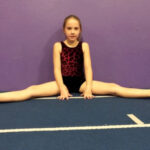
This is one of the simplest flexible stretches to help improve flexibility in your inner thighs and hamstrings. This is sitting with your legs wide apart and the body upright.
The straddle sit can be used to either start or end routines. But it is important for executing skills such as a split jump and any leap with a switch leg action. By training this position, you increase your flexibility and readiness for more complex, range of motion specific movements.
3. Multiple Jumps:
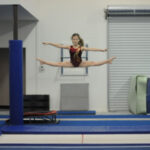
Several jumps are a few sequences of hops, skips or smaller than common-place jumps. This is done to help in understanding the endurance, rhythm, and control during sustained movements.
Secondly, jumping also engages the leg muscles and helps to strengthen all of them which provides a rigid base for more advanced flying techniques. The further you go, the more vital it is to double-jump reliably.
4. Standing on one foot:
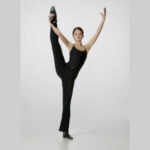
Simple yet effective, one of our favorite exercises for balance and stability is to stand on one foot. This skill definitely necessitates a stable core, you must balance on one foot while raising your other leg either in front of or behind you.
This is a fundamental skill for gymnastics and it will be used during many of the skills with turns, jumps, and poses. Standing on one foot helps develop balance and muscle control you will need to perform more advanced skills with confidence.
5. Half-Turn Jump:
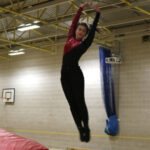
The half turn jump is a simple, one foot take-off at 180-degree rotation in the air and landing on the opposite leg. It teaches spatial awareness, coordination and how to move your body as one in the air.
It is important that gymnasts master the half-turn jump before moving on to more difficult turns and twists in their routines.
6. Tuck Jump:
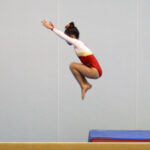
This is another plyometric exercise which, in simple words, means you should jump from both feet with bringing your knees toward your chest while being off the ground.
This move can build the power in your legs and also help with maintaining a strong core. This move is critical and often used as a foundation for more complex aerial skills. Such as tucks fronting and back to make it one of the important in any gymnast skill set.
7. Log Roll:
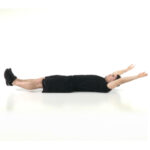
A log roll movement from your side to its opposite is another variation of basic rolls. This helps in coordination and body control to maintain a straight position around the axis of rotation.
The log roll in gymnastic movement is one of the first any child learns. It prepares him for later development in more complicated rolls and tumbles.
8. Bridge:
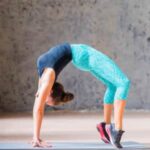
Then comes the bridge – a basic gymnastic move that requires laying on your back and raising yourself up by pushing with both hands and feet to create an arch shape.
It promotes flexibility in the spine, shoulders and hips while building strength through the back and arms. For circus performers, the bridge is an essential part of advanced skills like backbends and walkovers or handsprings on beam.
9. Tripod:
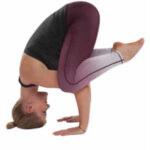
The tripod is the foundational balancing skill where you balance on your head and hands with knees resting on elbows. The pose is excellent for targeting balance and upper body in general as hitting your chest, arms, shoulders or core will ensure dramatic changes!
This is a very early example of a prep move for more advanced techniques like the headstand or handstand. It does stack you so that your upside down which means all the coordination required to maintain control in an inverted position.
10. Forward Roll (Basic Somersault):
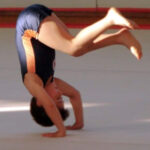
One of the first tumbling skills a gymnast is taught, is the basic somersault or front roll. It’s a forward roll from standing position to seated or standing again.
The forward roll works on body awareness, coordination and the ability to control on one’s momentum. The basics that we cover in this part are also the building blocks for any rolls, flips and tumbling sequences.
11. Backward Roll:
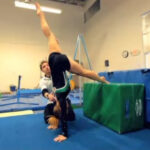
A backward roll is the opposite of a forward rolls. It involves rolling backwards over top of your head and shoulders from an inverted seated position and suspended bent achieve to stand.
This helps you learn to understand where your body is when it’s going in reverse. The backward roll is used in combinations for many higher-level tumbling skills, making it an important element to learn.
Basic Aerobics Skills
The basic gymnastics skills grow more sophisticated and difficult with body conditioning progress. They are the skills that define your routines, displaying power, strength, and flexibility manipulation.
This section will cover all of these vital gymnastics skills and tricks in easy way and give you a full break down along with progression steps so that you can learn them!
1. Handstand:
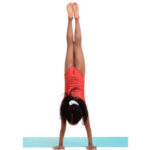
Among the fundamental calisthenics’ skills, you will learn a handstand. A simple exercise where in an upright position, you have your hands on the ground and keep legs straight with body as flat like a board or plank of wood. This is a move for which you need strong shoulders, arms, and core along with great balance to be successful in.
A handstand is the basis for rolling into tricks such as handsprings and handstand pirouettes. Regular practice of handstand will lead to improved body control in an upside-down position. It is a basic but explicit precursor accurate alignment required for many other advanced gymnastics skills.
2. Cartwheel and Round-off:

The round-off and the cartwheel are tumbling basics which rotate your body sideways by going around in a circle using hands or feet for direction. With the cartwheel being not only a gymnastic skill but also very much seen across Parkour, free-running and general balance.
It is definitely something we see early on in life. A round-off is a cartwheel that ends with both feet together and it leads into much powerful tumbling passes. They also serve as prerequisites for more advanced tumbling combinations.
3. Splits:
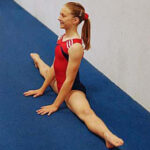
Splits are a versatility skill in which you open up your legs out to the sides so that it forms ideally an intermediate line with your body. This one is high on the list because it takes a lot of flexibility in your hips, hamstrings, and inner thighs.
Splits are vital for many aerobics, leaps, and jumps so it is a tell-tale sign of how flexible a certain gymnast can be. Consistent practice of the splits will give you more range in your performance.
4. Turn on One Foot:
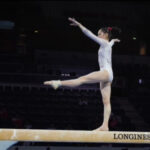
The turn is a single leg balance and coordination task where you spin your body on one foot. This is one of the basic cut steps in dance and athletic movements to improve control and precision.
Making sure you can turn cleanly and controlled is important as good turns play a critical role in making routines flow nicely. It involves the rhythm aerobics as well which looks better aesthetically, thus highlighting how paramount turning ability is to any gymnast.
5. Front and Back Handspring:
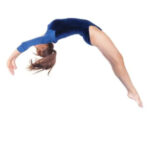
Front and Back Handspring are dynamic tumbling skills in which your body goes rapidly from a standing position to inverted. As you push off with hands and feet into an inverted position then rotating rapidly back over. These abilities demand strength, speed, and coordination of motion to create momentum.
The front and back flips on the other hand are fundamental of many moves in aerobics, resulting into more advanced gymnastics skills like tucks and layouts.
6. Cast:
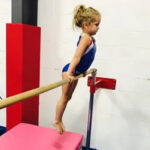
The cast is a skill on the uneven gymnastic bars where you push your body away from the bar keeping hollow and tight. This is a very important thing to do because it transitions the gymnast from one skill on bars to another. It also keeps the momentum needed for other gymnastics skills like kips or giants.
The cast is an important element for any gymnast training bar routines even at home before moving onto more difficult combinations.
Advanced Calisthenics Expertise
After the basics, test your skill level that demands a higher complexity of strength, precision and elegance. As these are the advantages of practicing advanced aerobics. They involve levels of coordination and control that are at the very limits of what human beings can do. These are high level tumbling and complex beam dismounts that showcase the greatest demonstration of a gymnast’s technical prowess.
In the area we delve into those advanced skills, breaking them down and offering some guidance on how to master their execution. When you master these gymnastics skills, it is when the lightbulb goes out and a new chapter begins for gymnasts; that of being an artist.
1. Advanced Tumbling:
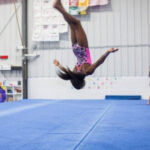
Once you reach more advanced tumbling skills, it becomes a set of high difficulty moves that are linked together such as layouts and double backs. These abilities require a high degree of power and coordination balanced with the aerial acumen to remain control in lights-out conditions.
The tumbling is sometimes the most exciting part of a gymnast’s floor routine, where they showcase their strength and precision. In calisthenics, handling these skills at a competitive standard and higher is super important to any success!
2. Release and Re-grasp:
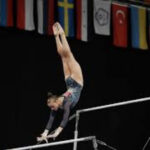
On the uneven bars or high gymnastic bars, some gymnasts with release and re-grasp skills let go of the bar, do a skill in mid-air before catching it again. They are some of the most difficult skills that gymnasts can perform.
They require perfect timing, strength, and bravery. It also involves how well characterized the gymnast’s level is because release and re-grasp moves can make out a very good bar routine.
3. Acrobatic Beam Combinations:
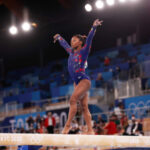
This includes different combinations of acrobatic elements (like back handsprings, aerials and layouts) on the balance beam. These combinations demand tremendous dynamic control, due to the need for advanced elements such as somersaults over a tiny surface.
Utilizing these acrobatics skills in successful beam combinations elevates the gymnasts. It determines if they can withstand this pressure of competition.
4. Precision Vaulting:

The third type is precision vaulting and you have to be precise in the way that can do difficult challenges by fulfilling them properly. It calls for a large amount of power, speed, and the need to accelerate while maintaining balance in tight spaces.
Precision vaulting is very important for good scores as it displays the gymnast’s control and consistency over difficult gymnastics skills.
5. Twisting Beam Dismounts:
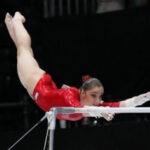
The twisting beam dismounts are probably the hardest and most impressive elements in athletics. As gymnasts, you understand that in order to land these dismounts, it required not only perfect timing but excellent body position.
The handspring twisting dismount starts with a quick and strong push off of the beam, creating rotation in your chest but keeping everything tight within to control the twist.
The twist, of course, further complicates things, because it asks you to remember how your body is rotating while also planning for a neat and safe landing. It is most perfected in every twist (full, double and more) elements of strength, agility. It focuses to ensure your feet hit the gymnastic mat with grace and precision.
Related Pick: Top Gymnastics Mats for Workout Enthusiasts
6. Intricate Floor Routines:
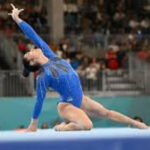
Complex floor routines, where artistry and athleticism collide. The floor exercise is your stage as a gymnast and each routine should blend powerful tumbling passes with graceful dance.
The dance is created to feature the strengths of a specific workout. It is potentially your remarkable tumbling weight or stylish dancing routines and fast transition from one stunt into another.
Each motion from the explosive tumbling passes to a flicker of dance choreography is performed meticulously. Amid all that technical difficulty and artistic expression is the great mystery of an intricate floor routine. Tumbling passes include skills like a double layout, power and execution. Same as dance elements including leaps turns.
In the most memorable routines, every movement contributes to an overarching narrative that hooks everyone. It showcases just how much skill and work goes into reaching this level of performance.
Injury Prevention & Recovery Tips
Gymnastics is an intense, dynamic sport that challenges your body’s physical capabilities – twists, turns, and landings require the utmost precision. But with great physical output comes the risk of injury. Which is why preventing injury is so much more than a bonus – it’s crucial to any gymnast’s routine.
This section helps you become aware of the top gymnastics injuries and prevent your body from any harm, so you can perform your best.
Common Gymnastics Injuries
Gymnastics injuries can be both minor and serious, usually as a result of repetitive strain or landing incorrectly. These are the most common:
- Sprains and Strains – Ankles are frequently sprained or strained when landing improperly or overstretched. Ankles or wrists are particularly vulnerable.
- Wrist Injuries or Fractures – From long periods of pressure from skills such as handstands, cartwheels, and vaults.
- Lower Back Ache – An everyday worry from arching, twisting, and tumbling. Most of these problems are caused by overuse or improper positioning.
- Shoulder Impingements – Gymnasts who train rigorous bar work or bridge-based gymnastics skills can be susceptible to shoulder tightness or inflammation.
- Knee injuries (like Osgood-Schlatter) – Often seen in the younger gymnast due to growth spurts combined with impact-based activities and a lot of pounding.
Warm-Up and Cool-Down: The First Line of Defense
Think of your body as elastic. When it’s cold, it gets stiff and can tear. But flexible and less injury-prone when warm. This is why you should warm up properly before heading to the mat.
- Warm-Up Tips:
- 5-10 minutes light cardio (jumping jacks, jogging in place)
- Dynamic stretches: leg swings, arm circles, hip openers
- Gradual movement to skill-specific drills
It is important to cool down after practice to avoid muscle stiffness and to help recovery.
- Cool-Down Tips:
- Slow walking or breathing exercises
- Static stretching: hamstrings, quads, back, shoulders.
- Hydrate to help muscles repair
Stretching Routines to Prevent Injuries
Flexibility is a gymnast’s superpower — that is, unless stretching goes wrong and does more harm than good.
- Pre-practice (Dynamic stretching):
- High knees, butt kickers, walking lunges
- Leg swings (front and side)
- Shoulder shrugs up and neck rolls
- Post-workout (Static stretching):
- Seated straddle stretch
- Bridge hold for back flexibility
- Shoulder stretches against the wall
What all of these movements do is restore mobility and help prevent tears, cramps , or stiffness.
Recovery Tools Every Gymnast Should Use
It’s not just about resting after tough workouts – it’s also about how you recover. They are a great way to aid in muscle recovery, alleviate aches and pains, and help keep you on track to train for your next competition!
- Foam Roller – It breaks up muscle knots, improves blood flow, and gives your muscles a better stretch. Apply to calves, hamstrings, and back post-practice.
- Massage Balls or Tennis/Lacrosse Balls – Great for minor muscle groups such as wrists, shoulders, feet, etc. Aids in releasing deep trigger points.
- Compression Sleeves or Socks – Used on wrists, knees, or calves to decrease inflammation and promote oxygen flow.
- Ice Packs or Cold Compress – For post-impact inflammation. Dip for 15-20 minutes in affected or sore areas of the body to reduce inflammation.
- Epsom Salt Baths – An all-natural solution to relieving tight muscles and stiff joints after a long training days.
Conclusion
It is a sport that requires strength, flexibility, precision, and artistic flair. Every aspect of a gymnast’s journey from the basics in those early levels to finally mastering some unbelievable routines by the elite level, is all based around dedication, hours upon hours of hard work and pure excellence!
Gymnasts are trained to reach beyond their grasp, transcend the limitations of body and mental strength of aerobics, and find joy in physical accomplishments. Whether you are only starting in Level 1 or a high-level competitor, each level that makes up your body mechanics journey is an opportunity to improve and succeed.
It is challenging and rewarding, the skills you learn and the routines that come with this sport are a direct reflection of how dedicated you truly are.
You Might Also Like to Read:

